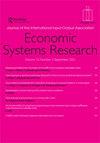2001-2008年美国经济的资金流动结构
IF 1.6
4区 经济学
Q2 ECONOMICS
引用次数: 2
摘要
咆哮的二十年代的伟大发明和生产力的大幅增长为美国带来了前所未有的繁荣。然而,在1929年秋季的黑色星期四之后,美国经济形势发生了巨大变化。为了确保大萧条的痛苦经历不会重演,资金流动分析的设计者韦斯利·米切尔和莫里斯·科普兰敦促人们更好地了解资金的流动,即支付方式。到目前为止,新世纪给我们带来了许多技术创新和新的经营方式。本文的目的是利用Tsujimura和Tsujimura([2018])提出的资金流动矩阵(付款人-收款人矩阵),了解过去二十年来资金在美国经济中的流动情况。美国量化宽松的资金流动分析。经济系统研究,30(2),137-177。https://doi.org/10.1080/09535314.2018.1443908)。新世纪的工业革命似乎没有足够的动力来流动资金,这是经济的命脉。本文章由计算机程序翻译,如有差异,请以英文原文为准。
Flow-of-funds structure of the U.S. economy 2001–2018
Great inventions and substantial productivity growth of the Roaring Twenties brought unprecedented prosperity to the United States. After Black Thursday in the fall of 1929 however, the U.S. economic landscape changed dramatically. To ensure that the bitter experience of the Great Depression does not recur, Wesley Mitchell and Morris Copeland, the architects of flow-of-funds analysis, urged a better understanding of the circulation of funds, the means of payment. The new century has so far brought us many technological innovations and new ways of doing business. The objective of the paper is to find out if and how well the funds have been flowing in the U.S. economy over the past two decades, using the flow-of-funds matrix (payer-payee matrix) proposed by Tsujimura and Tsujimura ([2018]. A flow of funds analysis of the U.S. quantitative easing. Economic Systems Research, 30(2), 137–177. https://doi.org/10.1080/09535314.2018.1443908). The industrial revolution of the new century does not seem to have enough momentum circulating funds, the lifeblood of the economy.
求助全文
通过发布文献求助,成功后即可免费获取论文全文。
去求助
来源期刊

Economic Systems Research
ECONOMICS-
CiteScore
5.60
自引率
4.00%
发文量
17
期刊介绍:
Economic Systems Research is a double blind peer-reviewed scientific journal dedicated to the furtherance of theoretical and factual knowledge about economic systems, structures and processes, and their change through time and space, at the subnational, national and international level. The journal contains sensible, matter-of-fact tools and data for modelling, policy analysis, planning and decision making in large economic environments. It promotes understanding in economic thinking and between theoretical schools of East and West, North and South.
 求助内容:
求助内容: 应助结果提醒方式:
应助结果提醒方式:


